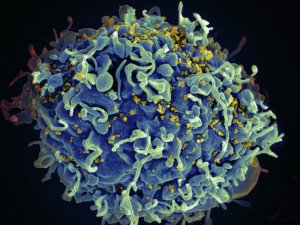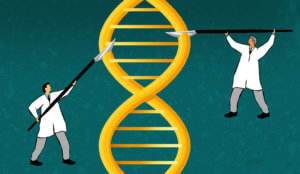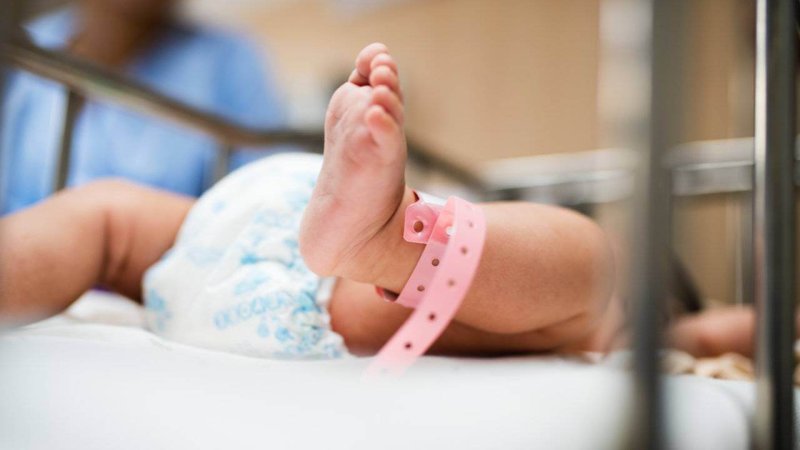Announced Jiankui He, then of Southern University of Science and Technology in Shenzhen, of his experiment:

Two Chinese girls … were born healthy a few weeks ago. Their mother Grace started her pregnancy by regular IVF with one difference: right after sending her husband’s sperm into her eggs, an embryologist also sent in CRISPR/Cas9 protein and instructions to perform a gene surgery intended to protect the girls from future HIV infection. The surgery reproduces a natural genetic variation shared by more than 100 million people of primarily European origin that confers strong resistance to initial HIV-1 infection and disease progression.
The CCR5 gene was discovered and described in 1996. It encodes part of the protein receptor gateway that HIV must cross to infect a human cell. The mutation takes out 32 DNA bases (it’s dubbed delta 32), something CRISPR could do too. People who naturally have the mutation are indeed protected from HIV, those with two copies to a greater extent than those with just one.
But the new study reveals that the mutation’s protection against HIV comes at a cost: increased mortality risk. And the discovery begs a broader question: If an application of CRISPR introduces a change later found to be dangerous, can the gene be un-edited?
Will CRISPR-in-the-clinic come with an antidote, or fail-safe mechanism?

The Berlin patient
The ability of CCR5 delta 32 to protect first made headlines in 2008, with the story of the “Berlin patient.”
Forty-year-old Timothy Ray Brown had a stem cell transplant to treat leukemia, at a hospital in Berlin. He had been HIV-positive for more than a decade and on anti-retrovirals for 4 years, and the blood cancer was his first serious AIDS-related illness. After the stem cell transplant, not only was his cancer gone, but the virus had also beat a retreat. Undetectable.
Brown’s stem cell donor was one of the 0.5 percent of Caucasians who have two copies of CCR5 delta 32. HIV couldn’t enter the donor’s cells, and the virus was similarly shut out of Mr. Brown’s cells. Since then, researchers have been trying to mimic the natural protection.
In March 2019, a second case of vanquishing HIV via stem cell transplant happened at the University of Cambridge and made headlines. Mr. Brown remains HIV-negative.
Increased mortality
The new study associates having two CCR5 mutations with a 20 percent increase in mortality rate.
Xinzhu Wei and Rasmus Nielsen, from the department of integrative biology and statistics, University of California, Berkeley, consulted all-cause death records from 409,693 individuals in the UK Biobank for CCR5 mutation status. Individuals who had two copies of the deletion mutation were about 20 percent less likely to reach the age of 76, compared to those who have two normal copies of the gene or just one mutation.
Although the researchers didn’t pinpoint the causes of death among the double deltas, they found that people with two copies of the mutation were underrepresented in this large cohort. So people bearing a double dose are at some unknown disadvantage.

The researchers identified nearly 6,000 places in the CCR5 gene that vary in the population, but the mutation removes only 76 of them. So it isn’t clear exactly how the altered co-receptor protein blocks HIV.
Studies in other populations are important though, because only 0.16 percent of Brits are HIV-positive. In populations with more infected individuals, inherited protection might be easier to tease out.
Not a surprise
Hints already abounded that inheriting resistance to HIV through a double dose of delta 32 comes at a cost.
The trade-off is heightened susceptibility to certain other viral infections, including West Nile Virus, tickborne encephalitis virus infection, hepatitis C, and one small study showed higher mortality from flu.
But genetic trade-offs are well known. The classic example is the protection against malaria in people who are carriers of sickle cell disease. They have enough sickled cells to keep out the parasite but not enough to give them anemia. Natural selection – a variation called balancing selection – maintains the mutation in the population as long as it provides an advantage.
CRISPR controls
Caution Wei and Nielsen in the new report:
[I]ntroduction of new or derived mutations in humans using CRISPR technology, or other methods for genetic engineering, comes with considerable risk even if the mutations provide a perceived advantage. In this case, the cost of resistance to HIV may be increased susceptibility to other, and perhaps more common, diseases.
Fortunately, studying the control of CRISPR predates harnessing it as a biotechnology.
In nature, CRISPR-Cas9 is a pair of short repeated DNA sequences that surround bits of DNA in bacteria that have come from infecting viruses. The cell transcribes RNA versions of the repeats and their hugged viral DNA.
Then, these “guide” RNAs patrol the bacterial genome, recognizing and binding inserted viral sequences, bringing in CRISPR-associated (Cas) proteins. The Cas part is an endonuclease – an enzyme that snips DNA from an interior site (not an end).
The CRISPR repeats provide versatility, the guide RNAs specificity, and the Cas the molecular scissors.
So CRISPR in a bacterium is an immune defense; in biotechnology, it’s a precision cutting tool. Nature has provided several variations on the CRISPR theme.
I’m not too worried about the feasibility of undoing CRISPR. A search of Google Scholar reveals an already rich literature of how to do it.

That’s not surprising, because molecular biologists have been investigating the intricate controls of genes turning on and off since the late 1950s. Just a few years after Watson and Crick deduced DNA structure and the genetic code was being deciphered, French researchers François Jacob and Jacques Monod described the first genetic control system, in bacteria.
Their unravelling of the “lac operon,” which would become a milestone in molecular biology, described a trio of genes and their controls that enable E. coli to break down the sugar lactose. The response is only triggered in the presence of the sugar; otherwise, the cell shuts it off.
Control of gene expression has been under intense investigation ever since. Finding ways to reverse CRISPR has been part of its evolution as a tool.
Several research groups have developed ways to turn off the endonuclease part (Cas9) with a small molecule or flash of light. A recent paper in Nature Communications from CRISPR co-inventor Jennifer Doudna’s team targets the guide RNA part with small molecules. And researchers are auditioning new DNA cutting enzymes.
The ability to shut CRISPR down is one reason why we need to go slowly in embracing the technology. Dr. He’s famed twins now have an increased risk of not reaching age 76. Although they won’t get their father’s HIV infection, they face a higher risk of mortality from certain other infections, and perhaps other, still unknown, vulnerabilities, now stitched into their genomes.
The experiment was premature, if not completely unnecessary. We must respect that nature is unpredictable and, sometimes, counterintuitive until we learn more. And we can never know if we know it all. That’s what science is all about, continuing questioning, and why “scientific proof” doesn’t exist.
Ricki Lewis is the GLP’s senior contributing writer focusing on gene therapy and gene editing. She has a PhD in genetics and is a genetic counselor, science writer and author of The Forever Fix: Gene Therapy and the Boy Who Saved It, the only popular book about gene therapy. BIO. Follow her at her website or Twitter @rickilewis































